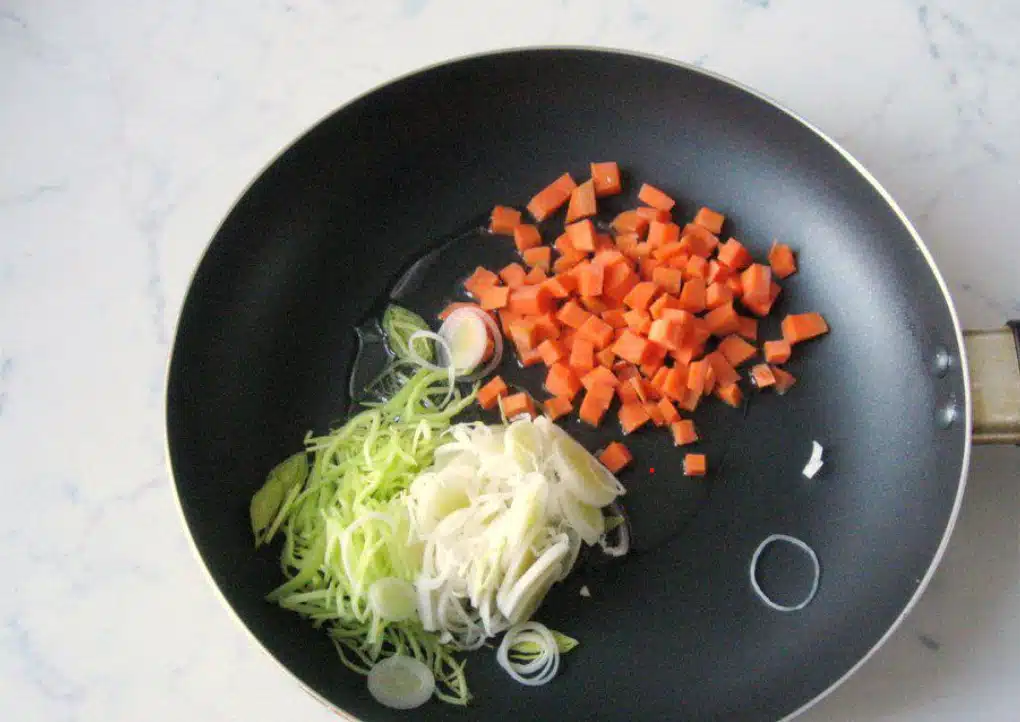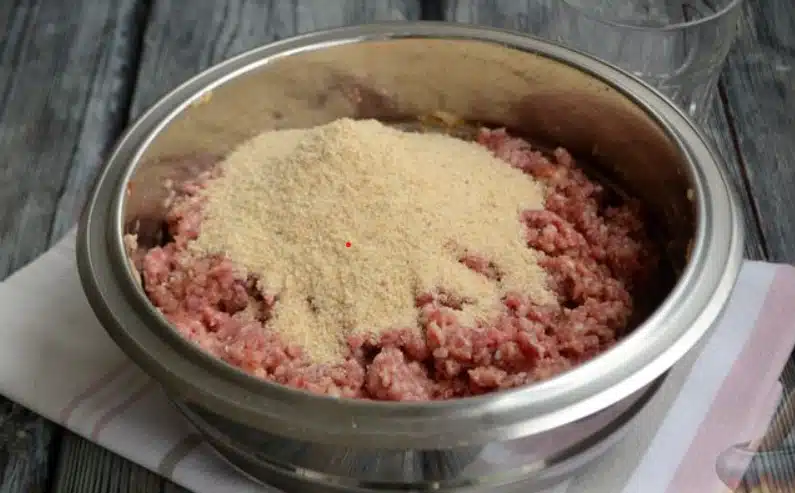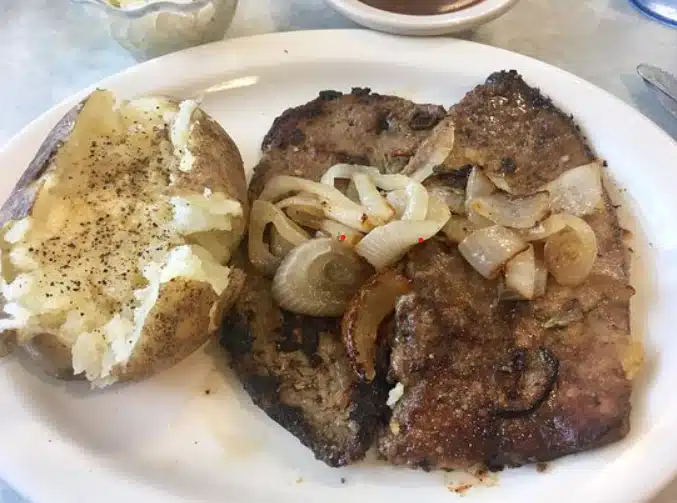While the exact Cheesecake Factory Meatloaf Recipe remains a proprietary secret, many classic meatloaf recipes capture a similar essence. Here’s a rendition that brings together savory ingredients, offering a taste reminiscent of that beloved dish. Dive in and see how you can recreate this delectable flavor at home.

Essential Meat Blend
Combine:
– 1 lb ground beef.
– 1/2 lb ground pork. (Or opt for all beef if you desire.)
Moisture and Binding Agents
Add:
– 1 cup bread crumbs.
– 2/3 cup milk.
– 2 large eggs.
Fresh Vegetables for Flavor
Toss in:
– 1 medium onion, finely chopped.
– Optionally, 1 bell pepper, finely chopped.
– 2 cloves garlic, minced.
Seasoning Mixture
Mix in:
– 1 tsp salt.
– 1/2 tsp black pepper.
– 1 tsp dried thyme or Italian seasoning.
– 1 tsp Worcestershire sauce.
Sweet and Tangy Topping
Stir together:
– 1/2 cup ketchup.
– 2 tbsp brown sugar.
– 1 tbsp prepared mustard.
– 1 tbsp apple cider vinegar.
Steps to Prepare
Starting Off: First, preheat your oven to 375°F (190°C).
Mixing the Ingredients: In a large bowl, combine the meat, bread crumbs, milk, and eggs. Next, fold in the onion, bell pepper, garlic, and seasonings.
Shaping the Meatloaf: Pour the mixture into a loaf pan or shape it on a baking sheet.
Applying the Glaze: Brush half of the ketchup mixture on top.
Baking Time: Bake the meatloaf in the oven for about 55-60 minutes. Aim for an internal temperature of 160°F (70°C).
Final Glaze Application: About 10 minutes before finishing, brush on the remaining glaze.
Serving: Once baked, let the meatloaf sit for 10 minutes. Then, slice and serve it.
Making a Delectable Meatloaf: A Cheesecake Factory Inspiration
Ingredients:
1 1/2 lbs lean ground beef
1/2 lb ground pork (or use beef if preferred)
1 cup bread crumbs (panko works well)
3/4 cup whole milk
1 medium onion, finely diced
2 minced garlic cloves
1/2 cup grated Parmesan
1/4 cup ketchup (keep extra for the glaze)
2 large eggs, whisked
2 tsp Worcestershire sauce
1 tsp dried herbs (thyme, oregano or a mix)
1 tsp salt
1/2 tsp black pepper
1/2 tsp paprika
Fresh parsley, finely chopped (optional for garnishing)
Creating the Perfect Glaze:
1/2 cup ketchup
2 tbsp brown sugar
1 tbsp cider or red wine vinegar
1 tsp Worcestershire sauce
Step-by-Step Preparation:
Oven and Pan Setup: Firstly, heat your oven to 375°F (190°C). Ensure you grease a loaf pan or if you prefer a different shape, a baking sheet.
Combining the Ingredients: In a large bowl, mix the beef, pork, bread crumbs, milk, onion, garlic, Parmesan, ketchup, eggs, Worcestershire sauce, herbs, salt, pepper, and paprika. Ensure a thorough mix but avoid overdoing it to retain tenderness.
Shaping the Loaf: Pour the meat mixture into your chosen pan. For a baking sheet, mold it into a loaf shape.
Crafting the Glaze: Next, in a separate bowl, stir the ketchup, brown sugar, vinegar, and Worcestershire sauce together. Generously brush half of this concoction over your meatloaf.
Baking Process: Place your creation in the oven and let it bake for about 45-55 minutes. The goal is to achieve an internal temperature of 160°F (70°C).
Final Glazing: As your meatloaf nears completion, with about 10 minutes left, coat it with the remaining glaze.
Rest and Slice: Once out of the oven, give your meatloaf a 10-minute breather before slicing. This resting period allows for juicier servings. Garnishing with parsley is a nice touch.
Understanding the Secret Behind the Moist Cheesecake Factory Meatloaf

When delving into the intricacies of creating a moist meatloaf, much like the renowned Cheesecake Factory version, several components come into play. Here’s an insightful breakdown:
Ground Meat Blend: Initially, selecting a combination of meats, notably beef, pork, and veal, paves the way. This mix not only introduces diverse flavors and textures but also ensures that the fat incorporated lends the meatloaf its requisite moisture.
Breadcrumbs and Milk Fusion: By immersing breadcrumbs or fresh bread in milk, forming what we commonly call a “panade,” the meatloaf gains tenderness and moisture. This element acts as a pivotal binding agent, preventing the meat from settling into a dense mass.
Incorporation of Eggs: Eggs, besides their role as binders, pour in added moisture.
Vegetable Addition: Introducing finely diced onions, bell peppers, or even shredded carrots can elevate both the moisture quotient and the overall flavor profile.
Perfecting the Cooking Technique: Here’s a key aspect – avoid excessively mixing the ingredients. Overmixing can lead the meatloaf to be too compact. Moreover, baking the meatloaf in a bain-marie or water bath can assist in preserving its moisture.
Glazing: Drizzling a glaze, be it tomato-centric, barbecue, or a sweet variant, can introduce an additional layer of flavor while ensuring the meatloaf’s external layer remains moist.
Transforming It Into A Full-Fledged Meal
Garlic Mashed Potatoes: Partner your meatloaf with mashed potatoes, richly flavored with roasted garlic and butter. For an added twist, sprinkle some grated cheese or chives.
Green Beans Almondine: To offer a contrasting texture and introduce a vibrant color, opt for green beans sautéed in butter and crowned with toasted almonds.
Dinner Rolls or Crusty Bread: Ensure you have some bread on the side, perfect for absorbing any residual sauce or gravy. Enhance its appeal with butter or a garlic-herb spread.
Refreshing Coleslaw or Caesar Salad: To counterbalance the meatloaf’s richness, a tangy coleslaw or a creamy Caesar salad can be the ideal choice.
Drink Pairing: As you savor the meal, a full-bodied red wine, like a Cabernet Sauvignon or Merlot, can be the perfect accompaniment. For those steering clear of alcohol, a chilled iced tea or lemonade fits the bill.
Dessert Finale: In the spirit of the Cheesecake Factory, culminate your dining experience with a slice of classic New York cheesecake, adorned with fresh berries or a sauce of your preference.
Why Consider Covering Your Meatloaf in the Oven?
When you’re ready to bake meatloaf, deciding whether or not to cover it can influence the final product. Here’s how:
Covered: Covering your meatloaf with foil helps in trapping moisture. As a result, the meatloaf remains juicy, especially beneficial when you’re working with leaner meats prone to drying. Furthermore, if moisture retention is a priority for you, then covering is the way to go.
Uncovered: On the other hand, baking the meatloaf without any cover allows it to develop a crispy crust on the exterior. Moreover, if you’re planning to introduce a glaze, letting the meatloaf bake uncovered ensures that the glaze caramelizes, adding a delightful flavor and texture.
Pro Tip: For an optimal result, consider starting with a covered meatloaf for the initial two-thirds of the baking time. Subsequently, remove the cover, apply your preferred glaze, and let the exterior brown.
Delightful Glazes to Elevate Your Meatloaf
Classic Ketchup Delight: Blend 1/2 cup ketchup, 2 tablespoons brown sugar, 1 tablespoon apple cider vinegar, and 1 tablespoon Worcestershire sauce together.
BBQ Flavor Burst: Take 1/2 cup BBQ sauce, mix in 2 tablespoons brown sugar, and finally add 1 tablespoon apple cider vinegar.
Sweet Honey Mustard Fusion: Combine 1/4 cup honey, 1/4 cup Dijon mustard, and a spoonful of brown sugar.
Fiery Sriracha Kick: Start with 1/4 cup ketchup, introduce 2 tablespoons Sriracha, add 2 tablespoons brown sugar, and conclude with 1 tablespoon soy sauce.
Oriental Teriyaki Magic: Stir 1/2 cup teriyaki sauce into 2 tablespoons of honey and sprinkle 1 tablespoon sesame seeds.
Rustic Maple Bacon Indulgence: Fry 3-4 strips of chopped bacon until they turn crispy. Extract the bacon bits and blend the remaining bacon fat with 1/4 cup maple syrup and 2 tablespoons Dijon mustard. Reintroduce the crispy bacon bits.
when it’s time to glaze, always remember to apply it during the last 15-20 minutes of baking. This approach ensures the glaze doesn’t burn. Set aside some glaze to complement the finished meatloaf, enriching its taste.
Key Ingredients for a Cohesive Meatloaf
In crafting a delicious meatloaf, several ingredients ensure its consistency. Here’s a breakdown:
Breadcrumbs and Oatmeal: The Prime Binders
To begin with, breadcrumbs stand out as a traditional choice. When incorporated, they absorb moisture seamlessly. Additionally, for those avoiding gluten, gluten-free breadcrumbs serve as an excellent alternative. On the other hand, oatmeal, whether in the form of quick oats or rolled oats, presents another viable option. These not only absorb excess moisture but also lend a unique texture.
Eggs: The Binding Champions
Next, eggs play a crucial role. They act as the central binding agent, with their proteins setting during cooking. This setting action holds the meat and other ingredients firmly together. Most standard-sized meatloafs will benefit from one or two eggs.
Liquids: The Subtle Connectors
Interestingly, a touch of liquid, be it milk or broth, aids in binding. When combined with breadcrumbs or oatmeal, it forms a pasty texture. This paste, in turn, binds the meat efficiently.
Vegetables: The Moisture Providers
Vegetables such as grated onions, carrots, or zucchini can also be beneficial. As they cook, they release moisture. This moisture, when absorbed by the breadcrumbs or oatmeal, enhances the binding.
Mixing: A Delicate Balance
While mixing, it’s vital to strike a balance. Overmixing can lead to a dense meatloaf. However, ensuring that the binding ingredients spread evenly remains essential.
Cooking: Shaping and Holding
Choosing between a loaf pan and freeform shaping on a baking sheet also matters. A loaf pan, for instance, helps retain the meatloaf’s shape. However, one should avoid packing the meat too tightly. When opting for freeform, maintain a substantial thickness to prevent crumbling.
Resting: The Final Touch
After baking, always allow the meatloaf to rest. This brief pause lets the juices redistribute, solidifying the loaf and making slicing smoother.
Meat Choices: Striking the Right Fat Balance
Lastly, the type of meat you choose can influence the meatloaf’s texture. A combination of meats, such as beef with pork, often yields the best results. Too lean a mix might result in a dry, crumbly meatloaf, while an overly fatty mix might lack structure.
Oiling the Pan for Meatloaf: Necessary or Not?
When you’re preparing meatloaf, one question that frequently arises is whether to oil the pan. So, let’s dive into the considerations.
Choosing Between Non-stick and Traditional Pans
If you opt for a non-stick loaf pan or baking sheet, often, there’s no need to add oil. Because of its special coating, the meatloaf usually doesn’t stick. Conversely, for those using traditional pans without a non-stick surface, it’s a good idea to apply a touch of grease. A swift spray of cooking spray or a brushed layer of oil typically does the trick.
Shaping Meatloaf on Baking Sheets
When you decide to shape your meatloaf by hand and place it on a baking sheet, lining that sheet with parchment paper or aluminum foil can be beneficial. Not only does this aid in a hassle-free removal, but it also simplifies the cleanup process. And if you’re still worried about sticking, lightly oiling that parchment or foil provides an extra layer of assurance.
Considering the Fat Content
Remember, meatloaf’s composition often includes ground meats with a range of fat contents. As the meatloaf bakes, this fat melts and can prevent sticking. However, if you lean towards using meats with lower fat, like turkey or chicken, a greased pan can be particularly helpful.
Enhancing Flavor and Moisture
Lastly, while this doesn’t directly relate to the question of oiling the pan, some cooks find that brushing the meatloaf’s top with oil or melted butter enhances its browning and flavor.
to oil or not depends on various factors: the pan’s type, the meat’s fat content, and personal preferences. But, when in doubt, a light grease can be a safety net against sticking.
Deciding Between Glass and Metal Pans for Meatloaf: A Comparison
Choosing the right pan for cooking meatloaf often comes down to a debate between glass and metal. So, when you’re faced with this choice, which one should you pick? Let’s dive in, taking into account key factors such as heat conduction and retention.
Understanding Heat Conduction
First and foremost, metal pans, particularly those crafted from aluminum or stainless steel, excel in conducting heat. Consequently, when you use a metal pan, it heats up rapidly, ensuring an even cooking surface. As a result of this superior conduction, your meatloaf might boast a more pronounced, crispy exterior.
Considering Heat Retention
On the other hand, glass pans have a knack for retaining heat for extended periods. After you pull your meatloaf from the oven, the residual heat in the glass continues to cook it for a bit longer. While this can aid in thorough cooking, there’s also a risk of overcooking if you’re not careful.
Factors Affecting Browning
Given that metal pans can attain higher temperatures swiftly, they often yield a more caramelized crust on your meatloaf’s bottom and sides. Many chefs and home cooks prize this browning effect.
Being Wary of Reactivity
We should also touch upon the potential reactivity of metal pans. Some metals, when in contact with acidic ingredients, can impart an unwanted metallic flavor to dishes. If your meatloaf recipe has a tomato base, for instance, an uncoated aluminum pan might not be your best bet. Here, either a glass pan or a non-reactive metal pan stands out as a preferable option.
The Visual Advantage of Glass
Lastly, with glass pans, you gain the added benefit of visual monitoring. Peeking from all sides, including the bottom, becomes possible. It’s a handy feature to ensure even cooking.
Conclusion: Making the Choice
Both glass and metal present their unique advantages for cooking meatloaf. If a crispy crust ranks high on your priority list, lean towards metal. However, if you value consistent heat retention and visual checks, glass might be your winner. Remember, aligning with your specific recipe and personal preference is key.
Essentials for Crafting the Perfect Meatloaf
While we’re on the subject, let’s touch upon the basic ingredients you’d need for a classic meatloaf:
Ground beef or a mix of meats
Bread crumbs or oatmeal
Eggs
Ketchup or tomato sauce
Worcestershire sauce
Chopped onions
Optional bell pepper, finely diced
Minced garlic
Seasonings: salt, pepper, and perhaps fresh herbs
A splash of milk or broth for added moisture
A glaze or topping to your liking
Cheesecake Factory-Inspired Meatloaf Delight
Essential Ingredients:
Gearing Up for the Meatloaf:
- Firstly, prepare 1 lb of ground beef.
- Next, get 1/2 lb of ground pork.
- Now, you’ll need 1 cup of breadcrumbs.
- Then, take 1/2 cup of milk.
- Also, set aside 1/4 cup of ketchup.
- Gather 1/4 cup of finely chopped onions.
- Grab 2 cloves of garlic and mince them.
- Ready 2 large eggs.
- For seasoning, measure out 1 tsp of salt, 1/2 tsp of black pepper, 1/2 tsp of dried thyme, and 1/2 tsp of dried oregano.
Prepping the Onion Topping:
- Begin with 1 large onion, thinly slicing it.
- Additionally, have 2 tbsp of olive oil on hand.
- Lastly, season with 1/4 tsp each of salt and black pepper.
Whipping Up the Mushroom Gravy:
- First, take 1 cup of sliced mushrooms.
- Next, gather 2 tbsp of butter.
- Ensure you have 2 tbsp of all-purpose flour.
- Subsequently, stock up on 1 1/2 cups of beef broth and 1/2 cup of heavy cream.
- Finally, keep salt and pepper nearby for adjusting taste.
Step-by-Step Instructions:
Creating the Meatloaf:
- Start by preheating your oven to 375°F (190°C).
- After that, in a large bowl, combine all the meatloaf ingredients thoroughly.
- Once combined, shape this mixture into a loaf and then place it in your baking dish.
- Bake the meatloaf for approximately 45 minutes or until it reaches the desired level of doneness.
Caramelizing the Onion Topping:
- While your meatloaf bakes, heat the olive oil in a skillet over a medium flame.
- Immediately after, add the onions, seasoning with salt and pepper.
- Cook the onions until they achieve a rich caramelized texture.
Preparing the Velvety Mushroom Gravy:
- Melt the butter in a saucepan over medium heat and then introduce the mushrooms.
- When the mushrooms turn soft and browned, stir in the flour.
- Following this, gradually whisk in the beef broth until it starts to simmer.
- Reduce the flame and blend in the heavy cream. Adjust the seasoning with salt and pepper as per your preference.
Recommended Kitchen Products:
- A premium quality loaf pan ensures even baking of the meatloaf.
- For best results, use a non-stick skillet, especially when caramelizing onions or crafting the gravy.
- A sturdy whisk helps achieve that creamy, lump-free gravy.
Nutritional Insights:
It’s worth noting that this meatloaf offers a high protein content. The fat content remains moderate, mainly from the beef, pork, and cream, while the breadcrumbs and milk contribute some carbohydrates. However, for a detailed nutritional profile, using a dedicated calculator proves beneficial.
Is the Cheesecake Factory meatloaf good?
Conclusion:
In conclusion, making Cheesecake Factory Meatloaf at home is a delightful culinary adventure that allows you to savor the flavors of this restaurant favorite in the comfort of your own kitchen. With our detailed recipe and tips, you can create a moist and flavorful meatloaf that will impress your family and friends.
So, roll up your sleeves, gather your ingredients, and start cooking! Whether you’re a meatloaf enthusiast or trying it for the first time, this recipe will surely become a household favorite.
And remember, the secret to the perfect Cheesecake Factory Meatloaf is the combination of quality ingredients and a dash of culinary creativity. Enjoy your homemade masterpiece!
For more information on the history and variations of meatloaf, you can visit Wikipedia’s Meatloaf page.